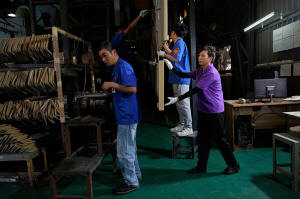|
The
official manufacturing purchasing managers index slipped to 49
in October from 49.8 in September, worse than forecast, the
China’s National Bureau of Statistics reported, based on a
survey of factory managers.
Measured on a scale between 0 and 100, a PMI reading below 50
indicates contraction.
On Thursday, U.S. President Donald Trump said the U.S. will cut
its fentanyl-related tariffs on China from 20% to 10% after his
meeting in South Korea with Chinese leader Xi Jinping, bringing
down U.S. tariffs on Chinese goods from 57% to 47%.
China has been diversifying exports from the U.S., with
shipments to regions including Southeast Asia and Africa
growing. Exports to the U.S., however, have dropped by
double-digits for six straight months.
A U.S. tariff cut means Chinese exports will be able to “regain
more competitiveness in the U.S. market and we could see some
recovery of direct exports to the U.S. soon”, HSBC economist
Taylor Wang wrote in a note on Friday.
But “despite tariff truce progress, global uncertainty continues
affecting manufacturing sentiment,” said Wei Li, head of
multi-asset investments at BNP Paribas Securities (China).
“U.S.-China agreements will likely prevent further deterioration
rather than drive a robust recovery,” said Li.
China’s eight-day Golden Week national holiday in October
contributed to slower factory activity, said Huo Lihui, chief
statistician at the Bureau of Statistics. But a “more complex
international environment” also contributed to October’s weaker
data, he said.
China is also moving to reduce its reliance on investment in
manufacturing that drives its massive exports, seeking to spur
stronger consumer spending, while attempting to curb price wars
and excess manufacturing capacity in many industries.
A prolonged downturn in the property market is weighing on
consumer confidence and on investments in construction and real
estate.
The ruling Communist Party highlighted those aims in documents
released after a top level meeting last week that mapped out
development priorities for the coming five years. They showed
that manufacturing will continue to be China's focus, building
on high-tech industries.
All contents © copyright 2025 Associated Press. All rights reserved

|
|




